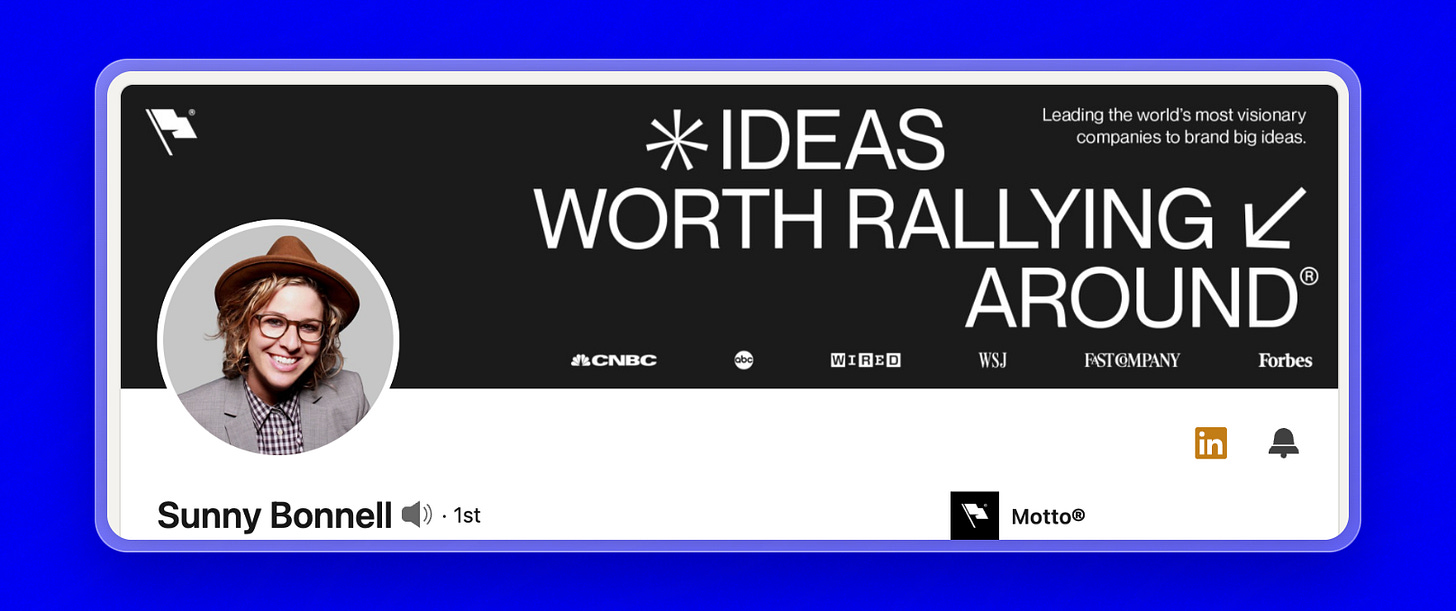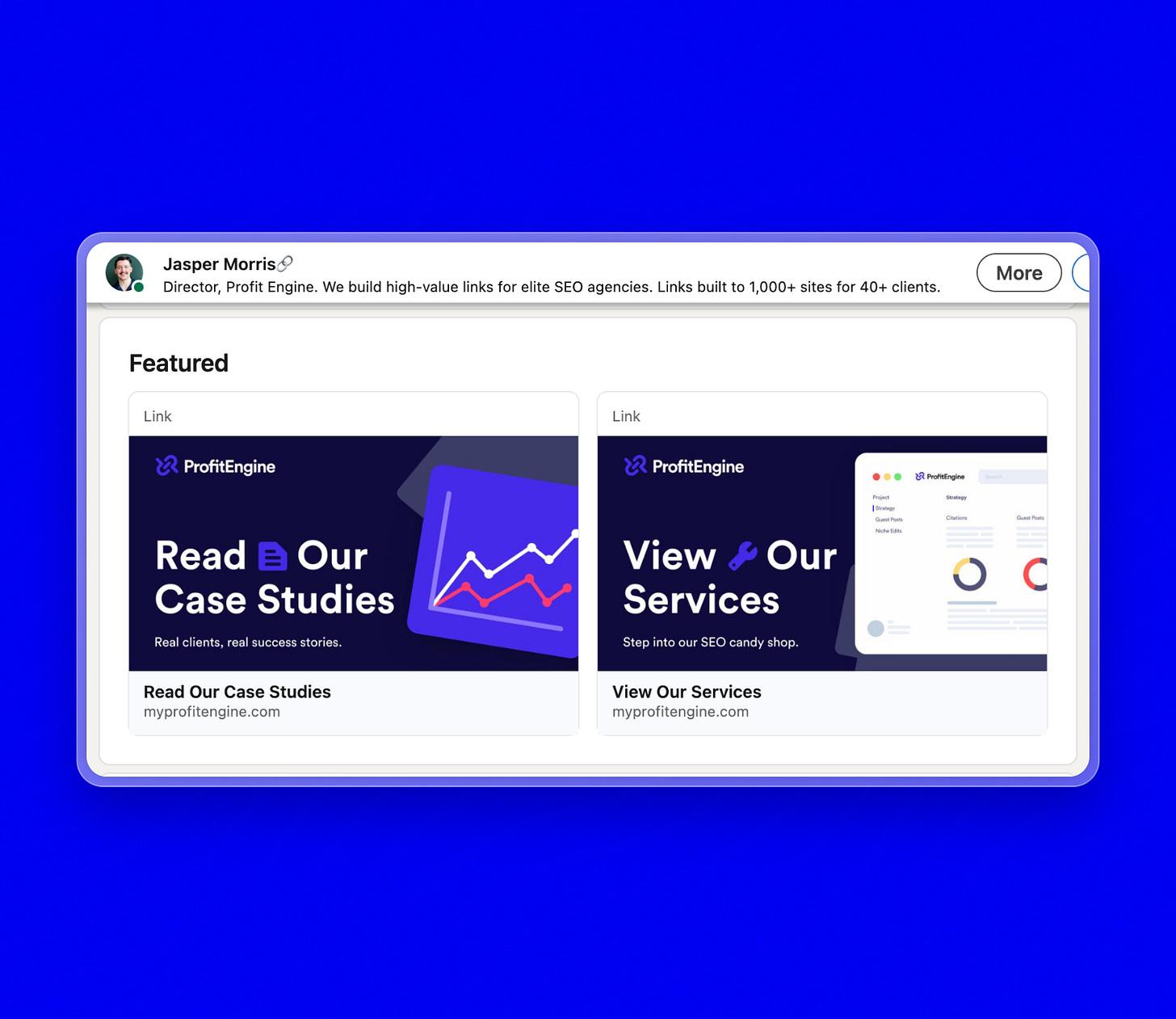How to Build a $1,000,000 LinkedIn Profile
Let's talk about how to optimize your LinkedIn profile.
Profile optimization is a top five “LinkedIn strategy” topic in terms of popularity.
People can’t get enough of it. And, to be fair, it is pretty dang important.
However, nobody actually tells you what it means to “optimize your LinkedIn profile.”
You’ll hear about “optimizing for conversions,” which is great, but how do you actually do that? What makes somebody convert?
The answer: credibility.
You have to convince people you’re actually worth paying attention to. Then, you have to direct said interest into an offer that’s actually appealing.
I extensively covered the concept of “selling something people want” in a previous newsletter, but I didn’t get the chance to explore profile optimization in depth—which is exactly what we’re doing today.
It’s one of those “boring fundamentals.” Not super exciting, but darn crucial, and not getting in right means setting countless opportunities on fire.
So sit down, strap in, and be prepared to (finally) get your profile right.
The Foundation
Before we dive in, let's establish what separates a mediocre profile from an exceptional one.
It's not just about having a professional headshot or a catchy headline—though those do matter. The real difference lies in how you present your value proposition.
Think of your LinkedIn profile as your digital storefront. Just like a brick-and-mortar business, first impressions matter immensely.
The difference between a $1 and a $1,000,000 profile mostly comes down to three core elements:
Clarity of Message: Your value proposition must be immediately clear to visitors. No jargon, no fluff—just pure, distilled value.
Social Proof: Evidence that backs up your claims through recommendations, endorsements, and tangible results.
Strategic Storytelling: A compelling narrative that weaves together your experience, achievements, and vision.
These elements work together to create what I call the "credibility trifecta"—the foundation upon which million-dollar profiles are built.
1. Clarity of Message
Let's look at Micah's profile as a perfect example of message clarity:
Instant Role Recognition
"CEO, North America @ UN/COMMON." No fancy titles. No buzzwords. Just exactly who he is and where he works—which speaks for itself.
Clear Value Statement
His headline/tagline continues: "We scale revenue for globally renowned D2C brands through Shopify, Klaviyo, and Yotpo."
In a single line, you know:
What they do (scale revenue)
Who they serve (D2C brands)
How they do it (through specific platforms)
Proof Points
"Throughout my time here, I've helped some of the world's most renowned eCommerce brands add 8+ figures of revenue..."
Followed by actual brand names: "Rare Beauty By Selena Gomez. Liquid Death. Rails Clothing. Magic Spoon."
Mission Alignment
"At UN/COMMON, we believe that good people want to do business with other good people." A clear statement of values that differentiates them from typical agencies.
The result? Anyone reading his profile knows exactly what UN/COMMON does, who they serve, and what they stand for—in seconds.
That's clarity.
2. Social Proof
AB's LinkedIn profile is a social proof powerhouse:
Market Position Statement
"The #1 TikTok Marketing Agency"—a bold claim by itself, but immediately backed up with evidence.
Logo Bar Credibility
High-profile clients prominently displayed: Hollywood Records, TikTok for Business, Miro, Uber Eats, and Logitech. Not just telling—showing.
Headline Power Play
"CEO, Clicks Talent—the world's first TikTok marketing agency." Claims both innovation and leadership in a single line.
Client Name-Dropping
"Clients include Sony Pictures, Amazon Music, Uber Eats, and more."
Notice the strategic choice of not only including recognizable brands but demonstrating sector diversity, too. This proves he’s a true master at his craft.
Network Validation
While I preach against followers for the sake of followers, his 5,000+ industry-relevant followers can (and do) provide immense social proof of his significant industry presence.
Visual Branding
Professional imagery, a cohesive color scheme, and platform-specific elements (such as the TikTok logo) reinforce the agency's specialty and legitimacy.
The key takeaway here:
Social proof isn't just about having impressive credentials—it's about presenting them in a way that creates an immediate trust response.
AB's profile does this masterfully by leading with results and backing them up with recognized brand associations.
Let's move on to the final element of our credibility trifecta...
3. Strategic Storytelling
Justin's profile is a perfect example of narrative structure done right—especially in his “About” section:
The Hero's Journey
He opens with impressive credentials: "Over the last decade, I helped build two companies past a $1B valuation and raise over $300M in venture capital."
Then, the twist: "Then, in 2019, I burned out."
The Pivot Point
He then establishes tension: "So, I decided to walk away from my high-paying executive job."
He follows up with even more intrigue: "But, before I could, I had a hypothesis."
The Vision
He shows clear foresight: "I believed building an audience online would be an incredible asset. That attention was the new currency..."
Obviously, he was right.
The Execution
First, he documents the journey: "So, I started building my brand on LinkedIn in early 2019."
Then, he follows up with clear metrics of success: "In just 6 months, I grew from zero followers to over 20,000."
The Transformation
From executive to entrepreneur: "And on August 1st of 2019, I walked away from my executive role..."
To current mission: "Helping 100,000+ solopreneurs build a fulfilling life through lean, profitable, one-person business."
The social proof validates it all:
698,399 followers
Featured in Forbes, Business Insider, Entrepreneur, VICE
"Top Voice" badge
Notice how each element builds upon the last, creating a compelling and credible narrative. Justin isn't just sharing his story; he's showing others a path they can follow.
This, my friends, is how you turn a profile into a movement.
Let's move on to implementing these principles in your own profile...
Optimizing Your Profile
Now that we've broken down what makes these profiles work, let's talk about how you can apply these principles to your own profile.
Here's your action plan:
1. Start With Your Story
What makes you unique isn't just what you do—it's why you do it.
Take 10 minutes and write down your journey:
What problem did you discover?
Why did you choose to solve it?
What unique approach do you bring?
Don't worry about making it perfect. Just get it on paper.
2. Identify Your Evidence
Make a list of everything that proves you know what you're talking about:
Client results
Previous roles
Major achievements
Brand names you've worked with
Press mentions
Revenue numbers
Remember: specific beats generic every time.
3. Clarify Your Message
Now, distill everything down to its essence:
Who exactly do you help?
What specific problem do you solve?
How do you solve it differently?
Your goal: Someone should understand your value in 10 seconds or less.
The Implementation Framework
Here’s how to put this in action, step by step:
Step 1: Your Banner
Use it to convey as simple, effective idea that represents your offer
Showcase your offer (like Sunny’s media features)
Keep it clean, professional, and on-brand
Step 2: Your Headline
Lead with your title
Back it up with specifics (what you’ve done, who you’ve served)
Load it with social proof (top clients, features, awards, etc.)
Step 3: Your About Section
Open with a strong hook
Tell your story quickly and concisely
Close with clear next steps for working with you
Step 4: Your Featured Section
Use this prime real estate strategically:
Lead magnets that solve immediate problems
Newsletter signup that promises specific value
Case studies showing concrete results
Free resources that demonstrate expertise
Each featured item should be a clear next step for your ideal client.
Step 5: Your Primary Button
Your primary button (the "hyperlink" or "Premium Button") should:
Link to your main offer
Lead to a high-converting landing page
Make it obvious what happens next
Tip: use the Premium Button—it won’t only feature more prominently on your profile than the “normal” hyperlink button—it’ll appear in your posts, too (which drives more traffic overall).
Step 6: Your Headshot
Your profile photo matters more than you think—it’s the first thing people look at, meaning everything else they evaluate happens in the context your photo creates.
Use a professional headshot (worth the investment)
Ensure clear lighting and a clean background
Match your brand's tone (casual vs. formal)
Keep it current (within the last 2 years)
Show your face clearly (no sunglasses or group shots)
People do business with people—a professional photo builds trust (and solidifies your credibility) before they read a single word.
The Real Secret
Here's what nobody tells you about credibility on LinkedIn:
You can't manufacture it…
…you can only represent it.
And that's actually great news.
Because it means you don't need to pretend to be something you're not. You just need to position whatever stage you're at effectively.
Are you new to your industry?
Perfect. Own it: "I'm new to [industry], which means two things:
You get my undivided attention and freshest thinking
I work on a performance basis in exchange for case studies"
Have three years of solid experience? Great. "I've spent 3 years mastering [specific skill], and here are the exact results I've generated..."
The key is alignment between your claims and your proof.
If you're Justin Welsh, you can talk about building billion-dollar companies. If you're just starting out, you talk about your dedication to client results and risk-free guarantees.
Both can work. Both can convert.
What kills credibility isn't being new—it's pretending to be something you're not.
And whatever credibility you DO have? Don't be bashful about it.
Did you:
Graduate from a great school?
Work at a respected company?
Generate even small wins for clients?
Master a specific technical skill?
Show it. Own it. Build on it.
What Matters Most
Remember: this isn't about creating the perfect profile overnight—it's about building a foundation you can improve over time.
”Profile optimization” is never actually done.
You’ll make constant tweaks, updates, and overhauls—and that’s a good thing. It’s part of the process. If you weren’t doing it, that’d mean you’re stagnant (which is, y’know, bad).
Start with what you have. Be honest about where you are. Focus on the value you bring.
Your profile will grow as you do.
Next Steps
Here’s what to do now:
Audit your current profile against my three criteria
Identify your biggest gaps
Use the examples we covered to fix it
Test and refine over time
Start there, and watch what happens. As long as you keep showing up with valuable content, your profile will convert visitors into clients, fans, and friends.
PS: I just launched my podcast with an interview of LinkedIn veteran Ben Wise—a LinkedIn ghostwriter of 8+ years. Check it out here.














A lot depends on the readiness to be visible or not, especially for corporate employees. Most are totally missing out on Social Selling activities. They are in fear to violate the outdated social media policies of their companies.
Impressive, and exactly what I was looking for as I got "revamp my LinkedIn profile at the top my my TODO of the week"
Thank you very much!